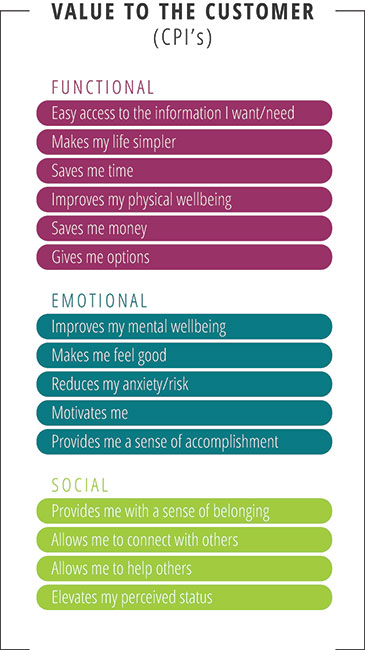Customer-centered innovation
Editor's note: Steve Crewdson is senior research lead at Gongos Inc. Grace Schafer is senior research implementation associate at Gongos Inc.
It’s been said many times before: The customer is king. A satisfied customer is the best business strategy of all. A customer’s perception is your reality.
While wonderful in sentiment, these platitudes are far from reality when it comes to business growth strategies. Practically speaking, organizations today largely set business goals – or KPIs – around profit, growth and operational efficiencies.
One can say that businesses that solely rely on customer satisfaction and Net Promoter Scores (NPS) as a proxy to gauge customer sentiment generally operate under the illusion that “active and satisfied customers’ needs are being met over the long-term.”
What these customer KPIs illustrate is the likelihood customers will purchase again down the road; in other words, the value customers are creating for the business. But where they fall short is providing an understanding of the value the business is creating for its customers beyond “value for the money.” Without digging deeper, brands risk being out of tune with what customers really want and are likely to overlook opportunities for customer-centered innovation and growth.
Another common myth
What can keep businesses from truly operating with the customer at the center of decision-making is yet another common myth: It’s not scalable, or even possible, to truly understand and act on customers’ individual needs.
This belief makes sense, given the limitless spectrum of potential needs and the fact that human mind-sets seemingly shift with the wind. But what if we were to look instead at what drives customers’ motivations and behaviors by evaluating what underlies and shapes those needs? We can refer to these as desired universal outcomes or customer goals but the idea is the same: they represent customers’ human hardwiring and they don’t change appreciably over time. This is the core concept of the values-based approach to understanding consumer behavior developed by Bain futurist Andy Hines and others: Why try to track thousands of shifting needs in real-time when we can focus on a fixed, stable set of metrics?
New research in this area reveals three universal goal categories, comprising a total of 15 customer performance indicators (CPIs) that help customers to function, thrive and succeed as human beings throughout their lives. And analysis validated the direct relationship between CPIs and customer lifetime value (CLV) with 90+% accuracy. Lastly, and perhaps most importantly, it has shown that as the number of CPIs executed on for a customer increases, so too does growth in CLV accelerate.
Three-phase process
 With the aspiration to create an exhaustive and exclusive list of universal human goals, two renowned sources in the customer value space were used as inputs: Bain’s Elements of Value (2018) and the (Dr. Andy) Hines Value Model. This desk research was the first of a three-phase process where we explored the 23 human need states that reflect the future of human consumerism.
With the aspiration to create an exhaustive and exclusive list of universal human goals, two renowned sources in the customer value space were used as inputs: Bain’s Elements of Value (2018) and the (Dr. Andy) Hines Value Model. This desk research was the first of a three-phase process where we explored the 23 human need states that reflect the future of human consumerism.
Using these two inputs, we developed a mapping exercise to match Bain’s 30 Elements of Value to Hine’s 23 human need states, combining those that serve the same need and discarding those that were redundant or non-universal. Rooted in Maslow’s hierarchy of needs, Bain’s four categories of value were used as a starting point to delineate functional, social and emotional needs. This allowed us to create an exhaustive set of desired consumer outcomes or CPIs.
We found that both of these frameworks encapsulate and organize perceived consumer values, though their elements are not mutually exclusive in the human goals they service. For example, two of Bain’s Functional elements of value – “reduces effort” and “avoids hassles” – can both ladder to the greater goal, “makes my life simpler.”
The third phase was conducting a quantitative survey across 20 leading, disparate brands to validate the 15 CPIs (Figure 1) to ensure they are both exhaustive and exclusive to one another. By validating the CPIs across disparate brands, we ensured focus on only the CPIs that are universally applicable across industries. Additional customer goals may be relevant when looking at a brand or industry in isolation.
A survey was fielded in August 2020 with 1,000 U.S. consumers who had recently purchased one of 20 leading brands’ products: 10 brands traditionally scoring high in the American Customer Satisfaction Index and 10 brands that scored lower on the same metric to ensure sufficient differentiation.
The analysis compared CPI scores to a preliminary calculation of future customer value (FCV) to test which potential CPI showed a relationship with business outcomes. For the purposes of this validation phase, FCV was calculated as a weighted average of three business outcomes:
- likelihood to recommend the brand to others (NPS)*
- likelihood to do business with the brand in the future (brand loyalty)
- current share of wallet held by brand vis-à-vis direct competitors
(*Note, in the syndicated results, NPS was replaced with frequency of spend when calculating FCV.)
Following our analysis, we found a statistically significant relationship between 15 CPIs and FCV – this proved and quantified the fact that CPIs drive financial business outcomes. Furthermore, we found that as performance on a single CPI increased, so too did the FCV, and additionally demonstrated a compounding effect, whereby as the number of positive CPIs increases, the predicted FCV also increases accordingly.
And lastly and of interest, we found that different CPIs had different levels of importance to customers of various brands. And while these patterns may seem logical, it demonstrated that CPI “importance” is unique to each brand, like a brand fingerprint.
Fixed set of goals
Understanding customers doesn’t have to be complex, nor ad hoc, when we shift focus away from their changing needs, experiences and expectations and drill into a fixed set of universal goals humans share – emotional, functional and social. CPIs can serve as accretive to KPIs and together become the North Star for both customer-centric mind-sets and business growth because they create an understanding of what businesses provide customers, as opposed to just the value that customers are creating for the business. It’s also a path to a better business strategy that realizes potential, finds new opportunities and maximizes returns.
